If LED manufacturers were a K-pop group releasing a catchy song with a repetitive chorus, it would probably be “price wars are killing me slowly.” It has been a recurring subject in LED manufacturers presentation at LEDforum in the last three years. Intense price competitions in the LED market over the last few years has caused manufacturers a lot of pain, with the worse still to come in 2016, said Sean Zhou, Regional Marketing Director Asia, Lumileds.
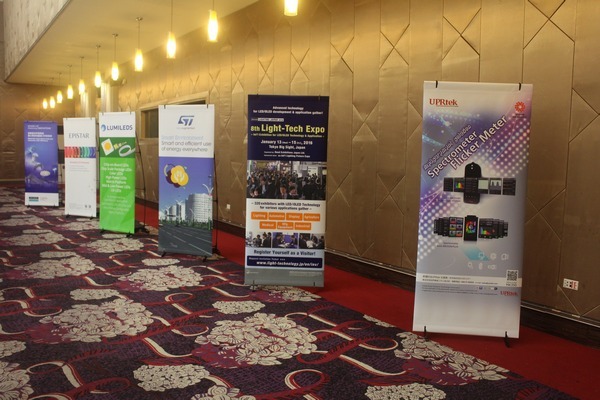 |
|
Sponsors of this year's LEDforum 2015. (All photos courtesy of LEDinside) |
Hold on a second. Does that mean it will be game over for LED manufacturers? Quite the contrary, where there is a will there will be a way. Manufacturers have continued to innovate, such as the rise of cost reducing flip chips or CSP LEDs in the industry. Others are investing resources in niche lighting markets including IR and UV LEDs to boost thinning profits in the lighting and backlight industry.
Before we delve into some of the important subjects covered by speakers at the recent LEDforum 2015,which took place in National Taiwan University Hospital International Convention Center, Taipei, Taiwan recently, one of the pressing questions to ask is why are manufacturers putting up with diluted profits? Is there really a silver lining out on the horizon for the diehard hopefuls in the industry?
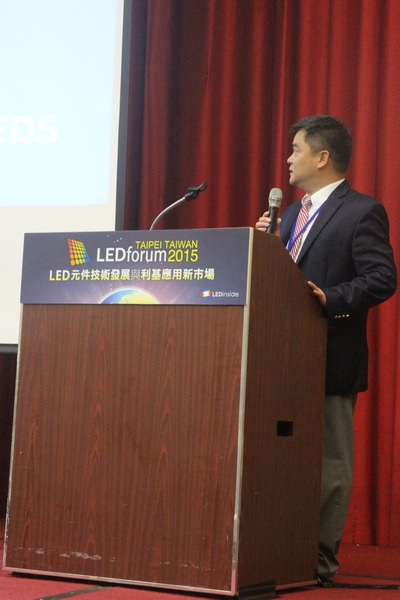 |
|
Sean Zhou, Regional Marketing Director Asia, Lumileds. |
LED industry still in phase of replacing traditional luminaires
Upholding an optimistic outlook, Zhou noted LED light sources low market penetration rates indicated there was still a relatively large untapped market waiting to be explored. The LED industry can be divided into three stages, and the industry is still at the first level of replacing traditional luminaires, he added. The first stage is defined by replacing traditional lighting sockets and bulbs, which is still an ongoing process, and expected to peak in the next three years.
The second phase is form factor innovation and connectivity, where there where be revolution changes in the bulb shape, and design to accommodate interactive connectivity. By third stage the LED luminaire or light source would be integrated into the architecture material. Based on Zhou’s presentation lighting system integration will become increasingly important in the near future.
In theory manufacturers should have a bright future in lighting applications. However, as noted by several speakers including Zhou, Walter Chen, General Manager of Marketing, Asia, Cree, and Carson Hsieh, Vice President, R&D Center, Epistar raging price wars in the lighting market has driven down LED manufacturers profits considerably. A positive development of lowered prices is it has sped up consumers’ adoption of the bulbs, but at the cost of manufacturers profitability. This has made more cost effective LED chip technology and niche markets increasingly important on companies’ business development agenda.
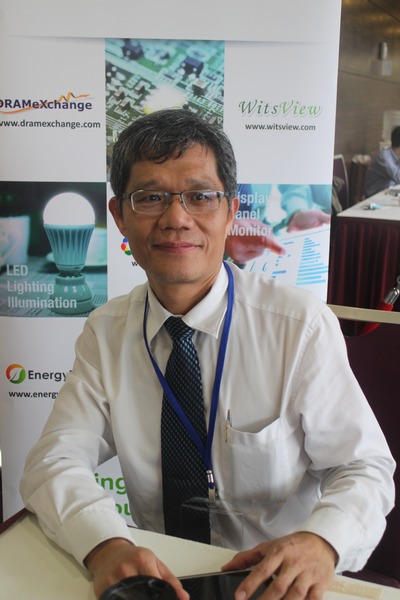 |
|
Carson Hsieh, Vice President, R&D Center, Epistar. |
CSP LEDs to penetrate TV backlight applications by 2016
CSP LEDs are playing an increasingly important role in the LED industry as manufacturers aim to cut manufacturing costs. The birth of CSP LEDs rose from LED manufacturers need to reduce production costs, since a smaller chip with the same lumen output would consume less raw materials. CSP LEDs has slashed prices by 40%, said Zhou.
Both Zhou and Hsieh noted CSP LEDs will penetrate LED TV backlight applications by 2016. Market rumors have pointed towards LG Display and Samsung’s interest in swapping traditional LEDs used in LCD TV backlight with CSP LEDs, which are much more compact, brighter and could reduce the number of LEDs used in the TV. LG and Samsung’s decision to switch to CSP LEDs will raise market penetration in the TV backlight sector significantly.
The two LED experts also agreed CSP LEDs would penetrate lighting applications at a later date than TV backlight, but projected different timelines. Zhou estimated the process would occur by 2016, but Hsieh’s projected it would occur sometime during 2017.
However, experts at the forum noted LEDs at most only consist 18% to 30% of a luminaire costs. Chen from Cree projected the LED would cost somewhere about 25% of a finished luminaire. This caps the extent of price reduction LED chips can make, and has forced manufacturers to seek other solutions to boost revenue.
 |
|
David Lucchetti, Director of Marketing and Application Industrial, Power and Discrete Group Greater China and South Asia Region, STMicroelectronics. |
Smart lighting the rising star of the future
With revenues shrinking in light source sector, manufacturers have been seeking alternative markets to raise revenue. IoT has definitely sparked manufacturers interest in smart lighting technology, with ST Microelectronics and GE Lighting speakers noting the market potential. ST Microelectronics noted the emergence of smart lighting products and emphasis placed on human centric lighting has made optimizing energy efficiency and reducing wasted power very important in smart lighting drivers, said David Lucchetti, Director of Marketing and Application Industrial, Power and Discrete Group Greater China and South Asia Region, STMicroelectronics.
GE has also developed in-door LED lighting positioning systems targeting retail market applications, said Yu-Ting Huang, Asia Product Manager, Indoor Fixtures, GE Lighting, who presented the company’s numerous smart lighting system and product portfolio at the forum.
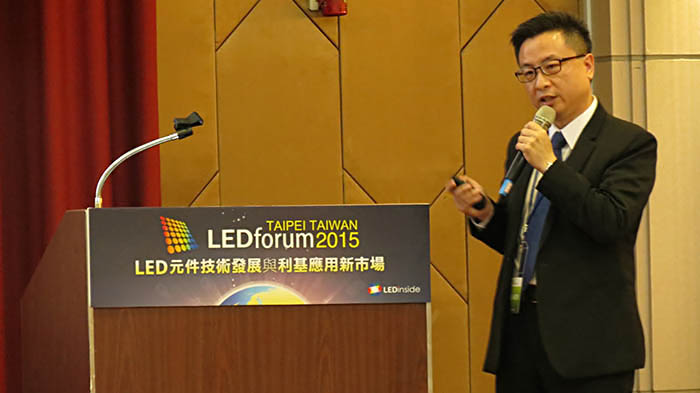 |
|
Charles Wei, Chairperson of High Power Lighting. |
UV LED developments
Eyeing higher profits and better revenues, many manufacturers have turned their gaze to UV and IR LED market. Epistar, which has had a comprehensive IR LED portfolio, has finally decided to scale up investment as the backlight market saturates and lighting profits are eroded by price wars. The company also intends to invest more in its UV LED products, but Hsieh was less optimistic about the market outlook for UV LEDs in the water disinfection market. UV LEDs low Wall-Plug Efficiency (WPE) of mere 3% was the main cause behind this pessimistic outlook.
However, NIKKISO Manager Cyril Pernot proved otherwise. Data presented at LEDforum 2015 supported Deep Ultra Violet (DUV) LEDs market potential and performance in the sector. The company’s UV LEDs could achieve a WPE of about 5%, and achieve an External Quantum Efficiency (EQE) of 10%. He also noted UV LEDs grown on AlGaN substrates on sapphire was more market competitive than other options on the market. Still, Pernot recognized DUV LEDs development costs were much higher than LEDs at the moment.
Additionally, Charles Wei, Chairperson of High Power Lighting and Hsieh both recognized UV curing LED market held the greatest market potential. Both were aware that the market for exposurers used in semiconductor presented the greatest market potential.
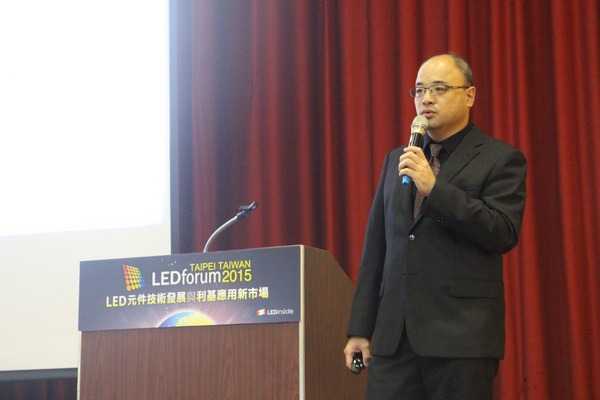 |
|
Hung-Wen Liu,General Manager of Body Engineering Division, HAITEC. |
LED automotive light adoption to grow
Aside from the above mentioned LED markets, manufacturers were also quick to recognize the market potential for automotive LEDs. Adaptive driving beams was highlighted by Hung-Wen Liu,General Manager of Body Engineering Division, HAITEC as an ongoing trend. The lights already applied in certain car models on the market, are capable of detecting lighting levels and dim or brighten accordingly, and even shift lighting around turns or bends. High costs, however, has kept the lights from proliferating the market. Another challenge for car light makers is the long verification process for car lights.
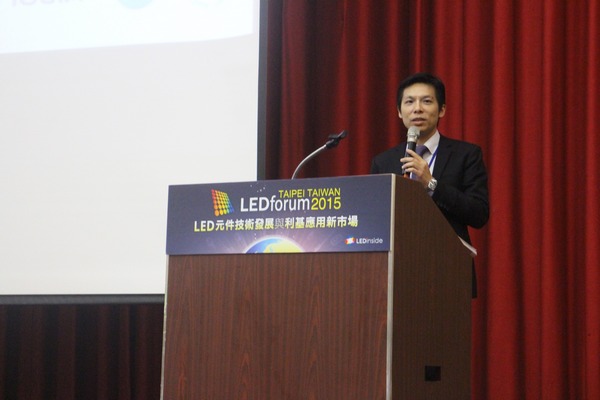 |
|
Roger Chu, Director, Research, LEDinside. |
LED market outlook for 2016
LED market growth is expected to slow down from 2016-2019, with CAGR expected to grow at a sluggish pace of 2%, said Roger Chu, Director, Research, LEDinside. The LED market value is expected to reach 14.52 billion (2% YoY) in 2015. Market growth is expected to ease in market applications including mobile, lighting, and automotive lighting sectors starting next year, but expected to rebound for large display markets. The display market will still be in the red after the rebound, but might have a chance to emerge from heavy losses by 2019s.
Other market trends will include the rise of Chinese LED chip and package manufacturers. In 2014, Chinese LED chip manufacturers LED chip revenue comprised 63% of revenue or US $5.49 billion. Low LED bulb prices will also become a market norm in the near future. LEDinside analysts were optimistic that small pitch LED displays, UV LED, IR LED, and wearable device applications will still present large market potential for manufacturers.
Saturated backlight market, and a nearly saturating lighting market will push manufacturers to develop most cost effective solutions or innovative to meet rising challenges. Low LED bulb prices does not spell the end for manufacturers, but will definitely urge manufacturers to rethink and reevaluate their strategies. In the near future, mass producing light sources will probably not be enough to generate a steady revenue stream. Companies will be pressured to search alternative market solutions in automotive lighting, IR LED, UV LED, wearable devices and other entertainment applications to generate profits.
(Author: Judy Lin, Chief Editor, LEDinside)





 CN
TW
EN
CN
TW
EN









